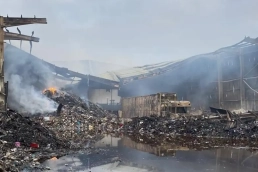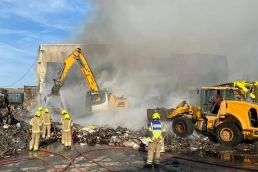Basildon Fire: The Importance of Early Detection in Industrial Safety
As of now, the cause of the fire at the Basildon recycling centre remains undetermined. However, given the inherent risks associated with recycling facilities, early detection might have significantly reduced the damage.
In the early hours of Saturday, September 14th, a substantial fire erupted at a waste and recycling centre in Basildon, consuming multiple warehouses and spreading through waste and vehicles on site. The blaze quickly escalated, requiring firefighters to remain on site for several days to dismantle and extinguish the burning debris.
Although fortune has it that the fire would erupt in the dead of night and therefore not endanger any human life, it’s also likely that, if people had identified the fire early, a lot of the damage could have been prevented. This raises an important question: could this have been avoided?
The inherent risks with any recycling centre
The recent fire at the Basildon water waste recycling centre illustrates the severe risks inherent to such facilities. Historically, recycling and waste management centres are prone to frequent fires, with an average of 300 incidents reported annually between 2001 and 2013. Water waste recycling centres face specific hazards due to the nature of their operations.
Despite primarily handling liquid waste, these centres often process materials that can become highly combustible, such as residual oils and chemicals. The heat generated by machinery and equipment, combined with accumulated debris and potential chemical reactions, significantly increases the fire risk.


Early detection is key
The exact cause of the fire at the Basildon water waste recycling centre remains unclear, but the incident underscores the critical importance of early detection in preventing and mitigating such events. Reported to the fire brigade at 1:15 AM, the fire demonstrates how quickly incidents can escalate when sites are left unsupervised, especially during off-hours. Construction sites and industrial facilities inherently carry fire risks, making advanced fire detection technology crucial in reducing these hazards.
While traditional heat and smoke detectors are commonly used in permanent structures, their application is limited in open-air or temporary environments. Thankfully, advancements in wireless technology have led to comprehensive solutions tailored for these challenging settings.
Ramtech’s WES3 and Linear Heat Detection systems provide an innovative and reliable approach to fire safety. The Linear Heat Detection system uses a continuous heat-sensitive cable that detects temperature increases over extended distances. When a fire or excessive heat is detected along any part of the cable, the system triggers an alert. This makes it ideal for large, open-air, or hard-to-monitor areas, such as scaffolding, external cladding, and industrial sites.
Both the WES3 system and the Linear Heat Detection solution work together to provide robust site protection. In the event of an activation, these systems immediately send real-time alerts via the REACT platform, ensuring that the right personnel are notified no matter where they are. These alerts can be accessed on mobile devices or desktop platforms, enabling quick responses and minimising potential damage.
Additionally, the IP67-rated Linear Heat Detection cable is designed to withstand harsh outdoor conditions, offering continuous fire detection in environments exposed to elements like dust, water, and extreme temperatures. With this technology, sites can enhance safety, respond faster to fire risks, and drastically reduce the potential for widespread damage.
Learning from our past
The fire has wreaked havoc on all the surrounding area. The BBC reported how a neighbouring company was affected by the destruction. Proving once again how damaging fires can be, even when people are not involved, someone always gets hurt. While early detection may not completely eliminate the risk of fire, it plays a crucial role in mitigating its impact. By enabling prompt identification and response, advanced fire detection systems can significantly reduce damage and limit the overall disruption caused by such incidents. Learning from past experiences, investing in effective early detection technology is a proactive step towards enhancing safety and minimising the adverse effects of future fires.
Photography Credit: Essex County Fire and Rescue Service